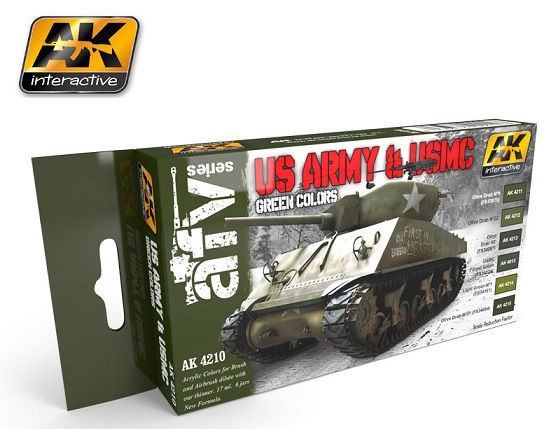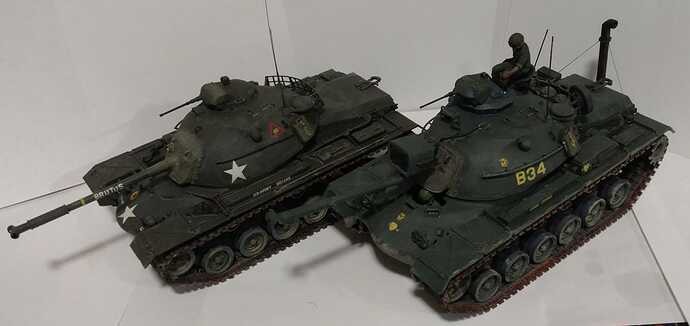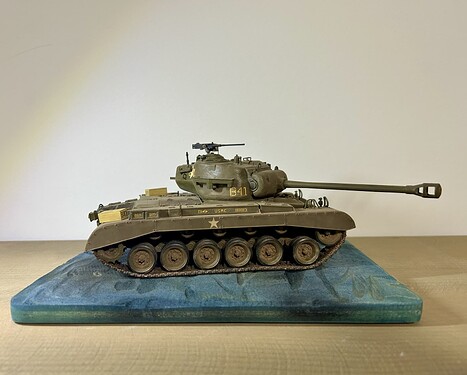If you enter it into a competition, then you by definition care about the opinions of other people about it. Which is part of why I stopped doing that ![]()
Which is why this model, along with all of my other builds, has not seen a contest in two decades. I don’t even post my builds online much, unless it’s to show a technique. So you’re right.
Oh… ok
Either way, I might just close the hatches… Is there an easy way to unstick cement or something?
If you are using Tamiya Extra Thin cement, a careful application of Tamiya Extra Thin cement will loosen the joint enough that you can get the pieces apart.
Thanks for the tip!
Emphasis on the “careful” part.
Ken
What’s that thing about putting it in the freezer?
[quote]I heard that doing your research before painting your model always helped.
I’m going to paint a M26 (from Tamiya) from the USMC Company B, 1st Tank Battalion, but there are little photos of the tank. There are black-and-white photos, but that doesn’t help…
I know that most U.S. armor was olive drab, but is there anything else I should know?[/quote]
Sorry I’m a bit late but in general, od green doesn’t have to be perfect, because in real life od green paints weren’t perfect and varied considerably. The paint quality varied and was known to fade. I remember having to paint equipment and the paint wouldn’t match from one can to the other despite coming from similarly marked cans.
As for models, there were a few times I didn’t paint my armor with od green. I simply built the model and sprayed it with Testors Dull Coat, then weathered it accordingly. Many of these kits are already moulded in od green, so sometimes I skipped this step, of course only if the model didn’t require filling or I was going to hide the imperfection with sandbags or equipment anyway
The subject of military paint could fill a book! But in my opinion, it doesn’t have to be perfect because paint on a tank takes a lot of abuse and the paints themselves were not perfect. As a quick rule of thumb, if your model represents a vehicle from WW2, to about the late 80s, you can use almost any od green color and apply them almost haphazardly because in this era, paints were often applied by their crews with anything from a broad brush to even mops. This included Merdec era camo patterns. The only era when the paint was professionally applied was when the Nato pattern was adopted. There are exceptions but thats it in a nutshell.
One more thing. Markings. There is some variance between Army and Marine armor. In many instance Marine armor were marked using yellow stencils. Army armor typically used white stencils and the typical white star (with exceptions). Marine armor tended to vary.
Edro
My HobbyBoss M-26. It was base coated with Testors OD from a rattle can. For weathering I use acrylic craft paints available in any arts & craft store like Michael’s, or Hobby Lobby. They’re cheaper than hobby paints or pigments, and there are many shades of browns and tans to choose from. For dust, I dry brush them on and use slightly different shades of color to vary the effect. For mud I use Acrylic Artists Gel Matte, it’s a white cream that dries clear and flat. It can be mixed with any acrylic color you desire. One thing to note, Tamiya ‘acrylics’ are not water based and can’t be mixed with the craft paints. Hope this helps a bit.
Small nitpick: olive drab is not green ![]() It’s much more brown with a green hue, and the idea that it’s green has resulted in a very large number of models painted in a colours that most definitely are not one of the variations of olive drab you could see in the real world
It’s much more brown with a green hue, and the idea that it’s green has resulted in a very large number of models painted in a colours that most definitely are not one of the variations of olive drab you could see in the real world ![]()
Hello Jakko, I understand nit picks, I have a few of my own. But to address your point, here is an article I dug up, which might help clear things up;
Green with envy over uniform color | Article | The United States Army.
My take on it, the initials O.D. was universally understood as Olive Drab. I don’t know why or who came up with that particular term to describe a color but the first word “olive” would imply in this context a shade of green because some olives are green. Of course olives also come in other colors, like black, but “black” is sufficient to describe this color.
Some may argue that O.D doesn’t mean Olive Drab, but “Over Dirt” or “Over Dents” as in who cares what you paint with this color
Don’t get me wrong, I do think your opinion and observations are probably accurate. Some versions of OD does look more like brown with green tint, but there are other versions that look more like pea green or maybe more puke green, yet also called Olive Drab.
Edro
That link goes to a question about uniforms, which were olive green (that’s what the OG in the designation stands for).
Olive drab paint was made from ochre (a yellow-brown) and black pigments — no green involved. This article by Steve Zaloga explains it pretty well.
Much confusion among modellers stems from there being both olive green and olive drab in American military speak, resulting in the two being mixed like you (and the article you linked to) do: “OD green” etc.
Probably too late but … AK 4213 (in set or by the bottle) is supposedly the darker post war USA Olive drab used. Second photo is US Army M48A2 (AK 4213 US 50s OD) and USMC M48A3 (AK 4013) in USMC Green.

Jakko, as I mentioned I do think your opinion and observations are probably accurate, because people perceive colors a bit differently. A few years ago there was this big internet argument over the colors of a dress. There were people perceiving the colors of that dress very differently from others. It became a big thing and revealed that not everyone sees the same things. So if you see Olive Drab as being brown with a green tint, that is fine. I happen to see OD as being green with a brown tint.
I brought up uniforms not as proof but how even the military can define something like their own military uniforms. Olive green is obviously a thing there. As for the paint, sure the paint can consist of pigments that are themselves not green. Here’s the thing about color, whether you’re using light or paint. Green is a secondary color consisting of two primary colors, which in this instance is yellow and blue. Green like all colors come in an extremely wide range of hues and shades. BTW brown isn’t a primary or secondary color. To make brown, you mix Red, Blue and Yellow. Altering the percentage of theses primary colors can result in a wide range of other colors, such as tan, sand, olive brown, olive green, etc.
The article you linked, explains Interwar-WW2 era Olive Drab but the original topic is about a USMC M26 Pershing in Korea which kinda falls outside the scope of the article. Compounded by the fact that the Marines had their own color requirements. And let’s not forget that there are numerous shades of what we call Olive Drab. Yes, some of them were more brown than green, but some were more green than brown and sometimes what started as one color ended up fading into another color. I remember the sand color in the old Merdec pattern would turn pink over time. The Earth brown sometimes faded into a reddish brown. Military paints weren’t the best quality, that is why I say, you don’t have to be perfect on the exact shade or even color because the real thing wasn’t perfect.
Edro
My point is a lot more succinct: it’s not green for the reasons Zaloga mentions in the article I linked to. For example:
Most tankers I have interviewed dont remember the colour their tank was painted, and those few that had some recollection usually described it as some dark colour or dark brown.
It’s pretty well-known by now that wartime American OD turned more brown as it aged.
I freely admit I’m not really up to speed on which colours the USMC painted their vehicles in the early 1950s. Perhaps they were left in Army OD, in which case the above does apply just fine because the shade would have been the same as during the Second World War, or for all I know they painted them Marine Green like in Vietnam, in which case the whole discussion about olive drab is moot because, hey, what do you know, Marine Green is green ![]()
Since we’re talking about painting a model here, though, IMHO the thing to do is try and work out what you think the colour was, and then find a model paint that you feel matches your mental image of it. If you think that’s green, then go ahead and paint it like that — it’s your model, after all. All I’m saying is that the real thing most likely was not actually military green.
My point is a lot more succinct: it’s not green for the reasons Zaloga mentions in the article I linked to. For example:
> Most tankers I have interviewed dont remember the colour their tank was painted, and those few that had some recollection usually described it as some dark colour or dark brown.
We could speculate on all the reasons why a WW2 tanker may or may not have remembered the exact color of their tank. But it would still be speculation on our part. I’m not saying that we should dismiss their testimony, but as mentioned before all of us do not perceive the same exact thing and this would also apply to them.
It’s pretty well-known by now that wartime American OD turned more brown as it aged.
That would sort of support my view. If OD appeared more greenish, over time it appeared more brownish. There really isn’t a right or wrong here.
Since we’re talking about painting a model here, though, IMHO the thing to do is try and work out what you think the colour was, and then find a model paint that you feel matches your mental image of it. If you think that’s green, then go ahead and paint it like that — it’s your model, after all. All I’m saying is that the real thing most likely was not actually military green.
Amen brother! I’ll share a story since we’re on the subject of painting models. A few years ago, somewhere around 1994-ish, I bought an Emhar WW1 Mark IV female. Back then, when I was researching the tank, there wasn’t much info about the color of these tanks. All the images I had were in black and white, and I didn’t have the internet at the time. I sort of liked the grey which the tank appeared in, in black and white photos, so thats what I painted it. I also added liberal amounts of mud to the sides to diminish the grey, but I was happy with it knowing that I really didn’t know the true color, until much later when I got to see a real WW1 era British Mark IV at Bovington, in 2005.
Edro
TS-28, baby!
I feel like TS-28 is much too light, I prefer Testors OD


